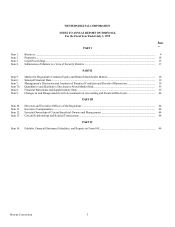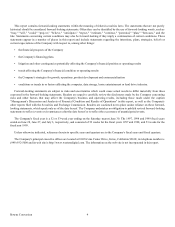Western Digital 1999 Annual Report Download - page 18
Download and view the complete annual report
Please find page 18 of the 1999 Western Digital annual report below. You can navigate through the pages in the report by either clicking on the pages listed below, or by using the keyword search tool below to find specific information within the annual report.Bowne Conversion 13
IBM relationship in 1998, and approximately $12.0 million related to the acquisition of Connex in 1999. Recurring research and
development expenditures for hard drive products increased by approximately $31.5 million from 1997 to 1998, and by $23.3 million from
1998 to 1999, due to the Company's decision to develop a full line of enterprise hard drives, regain time-to-market leadership in the
desktop hard drive market, develop a line of audio-visual hard drives and continue development of Connex new products.
For a discussion of product development, see Part II, Item 7, under the heading "Risk factors related to the hard drive industry in
which we operate."
Materials and Supplies
The principal components currently used in the manufacture of the Company's hard drives are magnetic heads and related head
stack assemblies, media, controllers, spindle motors and mechanical parts used in the head-disk assembly. In addition to its own
proprietary semiconductor devices, the Company also uses standard semiconductor components such as logic, memory and
microprocessor devices obtained from other manufacturers and a wide variety of other parts, including connectors, cables, and other
interconnect technology.
Unlike some of its competitors, the Company acquires all of the components for its products from third-party suppliers. In general,
the Company tries to have at least two or three suppliers for each of its component requirements. For example, the Company currently
buys giant magnetoresistive heads from IBM, Read-Rite and SAE. IBM supplies all of the heads for the Company's desktop PC hard
drives incorporating IBM technology under the IBM Agreement. Media requirements are purchased through several outside vendors
including Komag, IBM and HMT Technology. In connection with the sale of its media manufacturing division to Komag in April 1999,
the Company entered into a three-year volume purchase agreement with Komag. Under this Agreement, the Company is obligated to
purchase a substantial portion of its requirements for hard disk media from Komag. The Agreement does not require the Company to
purchase a fixed minimum amount of media from Komag. Some custom integrated circuits are currently sole-sourced from Cirrus Logic
and STMicroelectronics. Because of their custom nature, these products require significant design-in periods and long lead times.
For an additional discussion of component supplies, see Part II, Item 7, under the heading "Risk factors relating to Western Digital
particularly."
Backlog
At August 21, 1999, the Company's backlog, consisting of orders scheduled for delivery within the next twelve months, was
approximately $388 million, compared with a backlog at August 7, 1998 of approximately $270 million. The Company expects all this
backlog to be delivered within the current fiscal year. Historically, a substantial portion of the Company's orders has been for
shipments within 30 to 60 days of the placement of the order. The Company generally negotiates pricing, order lead times, product
support requirements and other terms and conditions prior to receiving a computer manufacturer's first purchase order for a product.
Manufacturers' purchase orders typically may be canceled with relatively short notice to the Company, with little or no cost to the
customer, or modified by customers to provide for delivery at a later date. Also, certain of the Company's sales to computer
manufacturers are made under "just-in-time" delivery contracts that do not generally require firm order commitments by the customer
until the time of sale. Therefore, backlog information as of the end of a particular period is not necessarily indicative of future levels of
the Company's revenue and profit and may not be comparable to earlier periods.
Patents, Licenses and Proprietary Information
The Company owns numerous patents and has many patent applications in process. The Company believes that, although its
patents and patent applications have significant value, the successful manufacturing and marketing of its products depends primarily
upon the technical competence and creative ability of its personnel. Accordingly, the patents held and applied for do not assure the
Company's future success.
In addition to patent protection of certain intellectual property rights, the Company considers elements of its product designs and
processes to be proprietary and confidential. The Company believes that its nonpatentable intellectual property, particularly some of its
process technology, is an important factor in its success. Western Digital relies upon employee, consultant, and vendor non-disclosure
agreements and a system of internal safeguards to protect its proprietary information. Despite these safeguards, there is a risk that
























